The complete monitoring experience for your phone
Get XNSPY and start tracking calls, texts, multimedia, locations and more on any phone!
Get Started Now Live DemoTeen love… innocent, care-free, spring-like, right? Well, that is how the rom-com and Disney movies have painted things for us. However, beneath the surface, there lie darker truths full of manipulation and exploitation.
If you are thinking that escalated pretty quickly, that is exactly how young relationships often unfold. Every year, countless teens face dating violence, and it is not always about overt bruises but emotional scars and silent fear that linger long after the relationship ends.
In this blog, we will uncover the concerning number of the teenage population who have fallen prey to such violence.
General Teen Dating Abuse Statistics

1. Across studies, approximately 19% of teenagers report experiencing some form of sexual or physical dating violence.
2. Teen dating violence statistics show that nearly half of all teens face stalking or harassment, while as many as 65% experience psychological or emotional abuse within dating relationships.
3. Roughly 1 in 10 high school students experiences physical violence from someone they are currently dating.
4. A study across 154 countries found that among girls aged 15-19 who have ever been in a relationship, about 24% report having experienced physical and/or sexual intimate partner violence in their lifetime.
5. Globally, over 1 in 5 women experienced physical and/or sexual partner violence in the past year.
6. A National Institute of Justice–funded study among dating teens found: 26.3% experienced cyber dating abuse, 29.9% physical, 47.2% psychological, and 13.0% sexual coercion.
7. More than two-thirds of youths (ages 12–18) who were or had been in a relationship reported they had been victimized (69%) or perpetrated relationship abuse (63%).
8. Around 22% of teenagers report experiencing at least one form of dating violence (physical, sexual, emotional, or digital) by age 18.
9. Approximately 1 in 4 teens say they have witnessed a friend being mistreated by a dating partner.
10. Only 27% of victims ever tell an adult or authority figure about their experience.
Don’t Forget to Check Out These Blogs
🔍 51+ Video Game Addiction Statistics: Latest Numbers and Trends
📱 99+ Teen Mental Health Statistics & Facts
🔥 89+ Phone Addictions Statistics + Ways to Deal With it
🛑 79+ Screen Time Statistics for Kids and Teens + Tips to Reduce It
Physical Abuse: Teen Dating Violence Facts
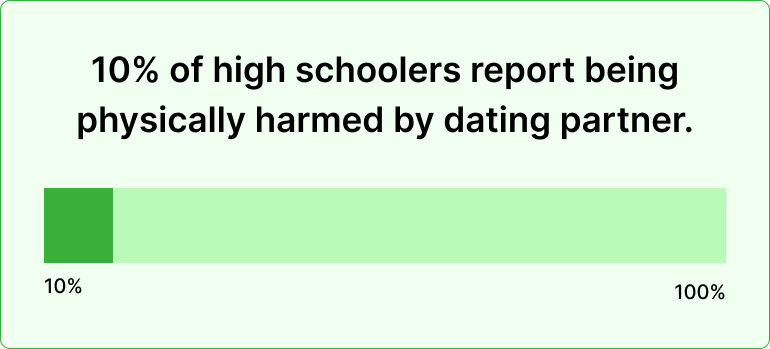
11. On average, 10% of high schoolers report being physically harmed by someone they date.
12. The YRBS study reaffirmed that among students who dated in the previous 12 months, approximately 1 in 12 (8%) experienced dating violence.
13. According to the CDC’s Youth Risk Behavior Survey, about 1 in 12 teens reported being physically hurt by a dating partner in the prior year.
14. In high schools, nearly 1 in 11 female and 1 in 14 male students report physical dating violence in the last year.
15. In a global systematic review of teenage dating violence, many studies report physical aggression prevalence in teenage relationships in the 15 – 25% range.
16. In an international meta-analysis of teen dating violence, physical victimization’s standalone prevalence across samples is often 10 – 30%.
17. 14% of those who experienced physical dating abuse report it happening more than once with the same partner.
Sexual Abuse: Statistics on Teen Dating Violence
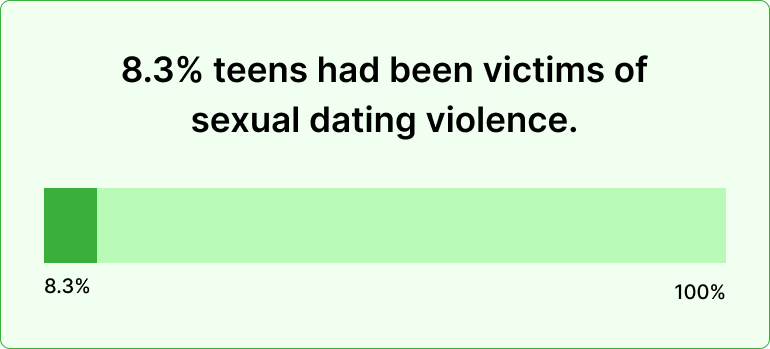
18. Surveys suggest that around 8.3% teens had been victims of sexual dating violence within one year.
19. Between 10% and 25% of girls aged 15 to 24 report having been raped or nearly raped, and in over half of those cases, the perpetrator was a dating partner.
20. Teens who experienced sexual violence between ages 14 and 17 exhibited poorer mental health outcomes.
21. The researched teen dating violence facts suggest that the rate of police-reported sexual dating violence against teens aged 15 – 17 was 60 victims per 100,000.
22. Among all teen victims of dating violence, sexual assault had higher rates than physical assault or harassment.
23. In a European intimate relationship study, pornography use, sexual coercion, and sexting behaviors were correlated with higher rates of reported sexual abuse in teen relationships.
24. 59.5% sexually abused people reported that it was by a dating partner.
25. About 7% of high school students report unwanted sexual touching by a dating partner.
26. 6% of LGBTQ+ teens report being sexually blackmailed by a partner.
Psychological Abuse: Statistics About Teen Dating Violence

27. 76% of teens report emotional/psychological abuse during dating relationships.
28. Among high school students, 73% of girls and 66% of boys reported experiencing verbal-emotional dating abuse.
29. Estimates for the prevalence of psychological/emotional abuse among teens in relationships vary widely, from 17% up to 88%, depending on definitions/methods/samples.
30. The Survey of Safety in Public and Private Spaces reported that 45% of teens aged 15 to 17 had been emotionally abused by a dating partner, the most prevalent type of abuse among this age group.
31. In studies exploring cyber / control abuse, 42% of participants claimed to have suffered “excessive control” via social media or smartphone at least once.
32. Statistics on teen dating violence claim that among youths in relationships or previously in relationships, more than two-thirds reported victimization or perpetration of harassment/stalking behaviors.
33. 52% say arguments with partners often include yelling, threats, or emotional blackmail.
Stalking: Statistics Regarding Teen Dating Violence
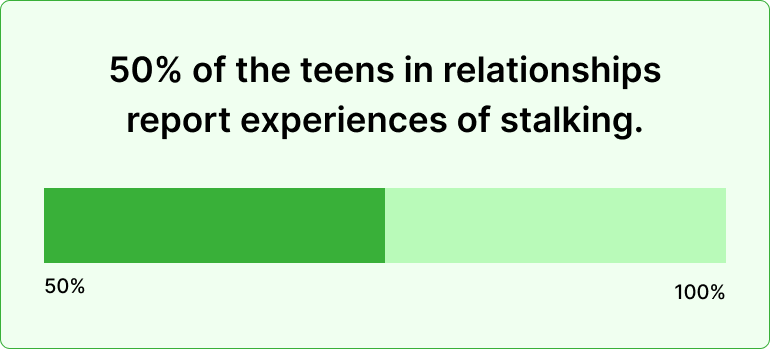
34. Approximately 50% of the teens in relationships report experiences of stalking, digital harassment, or unwanted monitoring by a dating partner.
35. In digital/cyber dating violence, 26.3% of teens reported experiencing cyber dating abuse, which includes stalking, monitoring, and harassment.
36. In control-behavior studies, 42% of participants (in a Basque sample) claimed excessive partner control over their social media or smartphone usage.
37. Unwanted monitoring, tracking, repeated messaging, or “checking up” behaviors are reported in many teen relationships, often in the range of 20 – 40%.
38. 25% of teens who experienced digital stalking later experienced in-person harassment from the same partner.
Experiences of Abuse in Teens: Gender-Wise Statistics
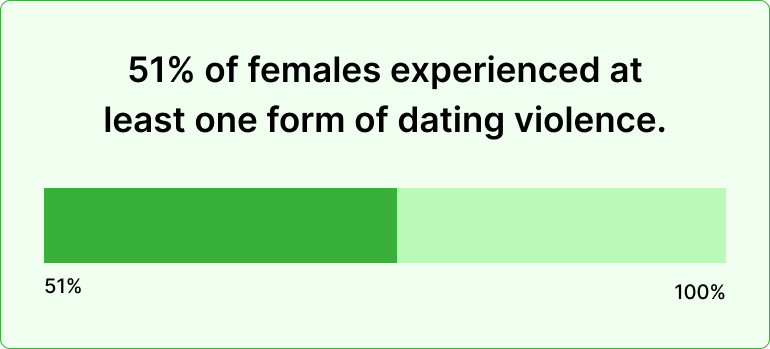
39. A study found that 51% of females experienced at least one form of dating violence.
40. When it comes to males, in comparison, the same study found 43% of them to experience teen dating violence.
41. Teen girls aged 15–17 faced police-reported dating violence rates nine times higher than those of teen boys.
42. Sexual dating violence was 23 times higher among girls (116 per 100,000) than among boys (5 per 100,000).
43. By age 19, almost 1 in 4 adolescent girls who have ever been in a relationship will have experienced physical, sexual, or psychological abuse by a partner.
44. Statistics about teen dating violence show girls report injury from dating violence more often than boys, even when rates of perpetration are more symmetric.
45. In U.S. high school data, about 1 in 8 female and 1 in 26 male students report having experienced sexual dating violence in the past year.
46. In a recent study of adolescent relationships, girls had a psychological abuse victimization rate of approximately 28.1%, and boys had 21%.
Country-Wise Prevalence of Dating Violence Among Teens
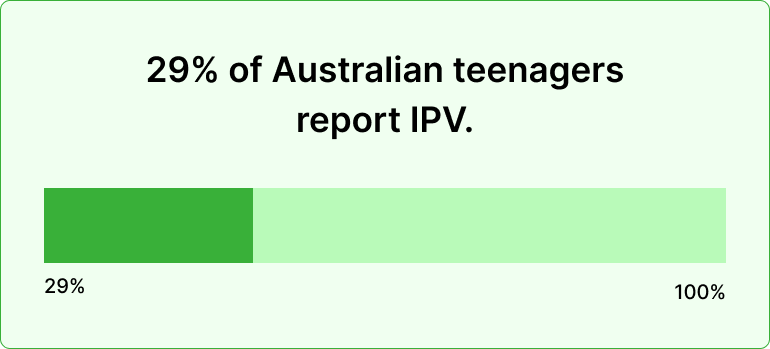
47. 29% of Australian 18-19-year-olds reported experiencing at least one form of intimate partner violence in the past year.
48. 41,057 Canadians aged 15 – 17 were identified as victims of teen dating violence.
49. The reports of teen dating violence in England and Wales have surged to 49%.
50. The lifetime prevalence of physical or sexual IPV among ever-partnered girls in the LMIC regions is approximately 24%.
51. Studies suggest that the perpetration rate of any dating violence is approximately 27.3% in China.
52. 30% or 1 in every 3 teens in Brazil report going through violence while dating.
53. 1 in 3.5 Indian teenage girls report facing dating violence, with emotional abuse being the most common.
54. 42% of youth aged 15 – 19 in Mexico undergo abuse at the hands of their dating partners.
55. In Colombia, around 28% of teenage girls face physical, emotional, or sexual violence in dating.
56. Rural regions of Canada reported double the rates of dating violence (478 per 100,000) compared to urban areas (241 per 100,000), with the rural North recording the highest rates (1,154 per 100,000).

Protect Your Teen Before It’s Too Late
Download Xnspy and stay informed of what’s happening in your child’s digital world.
– See call logs, texts, and social media chats
– Track location in real time
– Get alerts on keywords or contacts
– Review complete browsing history
Teen Dating Violence in the USA
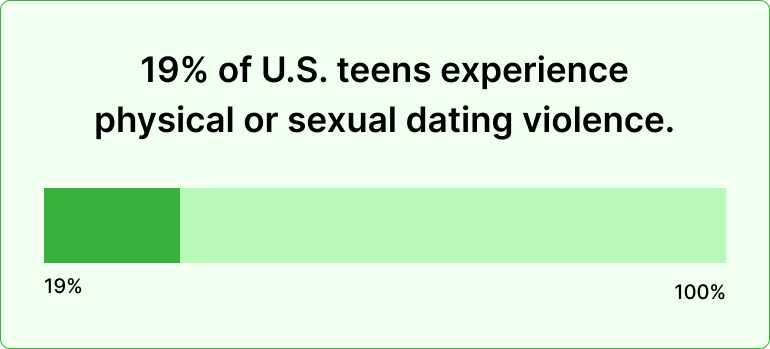
57. Roughly 10 – 19% of U.S. teens experience physical or sexual dating violence, while about half report stalking or harassment.
58. Emotional abuse affects up to two-thirds of U.S. teens, making it the most widespread form.
59. USA’s high school data show that nearly 1 in 10 students experience physical harm from a dating partner.
60. In the USA, among transgender youth, about 88.9% report experiencing dating violence.
61. Also, data suggest that about 1 in 12 high school students experience sexual violence in a dating relationship in a 12-month period.
How to Prevent Teen Dating Violence: 4 Proven Ways
1. Use Xnspy Phone Monitoring App

Xnspy parental monitoring app is one of the most reliable solutions for preventing teen dating violence. The app comes with a quick installation procedure and an easy-to-understand web dashboard. With its real-time updates, Xnspy makes sure that the parents are always aware of their children’s online activities and interactions.
As tech is what keeps teens in the loop with one another, devices are the first scenes where signs of violence can show. With Xnspy’s stealth monitoring, you can stay aware of your child’s text messages and social media chats.
Moreover, as you can set up a customized list of watchlist words, Xnspy will send you instant email alerts if any predefined abusive words appear across your child’s device. To know who they are talking to and what they are talking about, you can see the contact details and record voice calls as well.
Xnspy also takes periodic screenshots and records every keystroke from the targeted cell phone. With the help of these two features, it becomes easier for you to get better context and see real-time activities and responses while they matter.
2. Create Teen Dating Violence Awareness for Prevention
Raising awareness is one of the most powerful ways to prevent teen dating violence. Teens often lack understanding of what constitutes unhealthy behavior in relationships, such as manipulation, jealousy, or isolation, and may mistake control for affection.
Awareness campaigns, school programs, and workshops can teach teens to recognize warning signs and promote mutual respect and consent. Educating young people about gender equality, emotional regulation, and communication skills can empower them to establish healthy relationships early in life.
Parents, educators, and community leaders must collaborate to ensure that prevention messages are consistent and accessible. Encouraging peer discussions, role-playing scenarios, and survivor testimonials can make the topic relatable and impactful.
By creating an environment where teens feel safe to ask questions and report concerns, communities can reduce stigma and promote proactive prevention. Awareness transforms silence into understanding and understanding into protection against dating violence.
3. Establish Clear Boundaries and Respect
Teaching teens to set and respect boundaries is essential to preventing dating violence. Every healthy relationship is built on mutual respect, open communication, and understanding of personal limits.
Parents and educators should help build teen dating violence awareness. They should help teens identify what makes them comfortable or uncomfortable in relationships, physically, emotionally, and digitally. This includes discussing consent, privacy, and how to say “no” confidently without guilt or fear.
Teens should also learn to respect their partner’s boundaries equally, understanding that love never involves control, pressure, or manipulation. Role-modeling respectful behavior at home reinforces these lessons, as teens often mirror what they observe in adult relationships. It’s equally important to address online boundaries, such as the right to privacy in messages, photos, and social media interactions.
Establishing clear expectations early helps prevent misunderstandings and reduces the likelihood of abusive dynamics forming. Respecting boundaries fosters trust, equality, and emotional safety, the foundation of every healthy relationship.
4. Provide Access to Support Resources and Counseling
Access to support and counseling can be life-changing for teens affected by or at risk of dating violence. Many teens struggle to recognize abuse or fear speaking up due to shame, confusion, or loyalty to their partner.
Schools, parents, and communities should ensure that teens know where to find confidential help, whether through counselors, hotlines, online chat services, or youth organizations. Professional counselors can help teens process emotions, rebuild confidence, and learn healthy coping strategies.
Support groups also provide safe spaces for sharing experiences and receiving peer encouragement. For prevention, schools should integrate mental health resources and relationship education into their curricula, normalizing help-seeking behaviors.
When a teen knows that support is available and judgment-free, they are more likely to report abuse early or avoid unhealthy relationships altogether. Empowering teens with accessible, compassionate resources is one of the most effective long-term strategies for ending teen dating violence.
Key Takeaways
- Across global and national data, physical, sexual, emotional, and digital abuse appear consistently prevalent, affecting a significant share of the teenage population.
- Far more teens experience emotional manipulation, control, or humiliation than physical harm.
- High rates of cyberstalking, unwanted monitoring, and harassment reveal that digital spaces amplify control and surveillance behaviors.
- While both male and female teens experience dating violence, female teens report higher rates of teen dating violence.
- Studies link teen dating violence to poorer mental health, trauma symptoms, academic decline, and future victimization.
- Despite widespread victimization, less than a third of teens confide in adults, pointing to shame and the normalization of abuse
Conclusion
Teen dating violence is a silent epidemic hiding behind the illusion of young love. What begins as affection can quickly turn into manipulation, control, or abuse and leave lasting emotional and psychological scars.
The teen dating abuse statistics reveal that this issue is neither rare nor harmless. It affects millions of teens worldwide across all cultures and genders. Awareness, education, and open communication are the strongest shields against such harm.
By teaching respect, boundaries, empathy, using phone monitoring apps, and giving teens access to trusted support systems, we can break the cycle of abuse and help them build safer, healthier relationships for life.
Sources
- American Psychological Association (APA)
- Australian Institute of Family Studies
- Bureau of Justice Statistics
- CDC
- Children’s Hospital of Philadelphia
- International Journal of Women Empowerment
- Future Without Violence
- Monique Burr Foundation for Children
- National Institute of Justice
- National Library of Medicine (1)
- National Library of Medicine (2)
- nh coalition against domestic & sexual violence
- NJ.gov
- Pub Med
- Reach
- Rutgers University School of Social Work
- Sage Journals
- Statistics Canada
- The Lancet
- UNICEF
- World Health Organization (1)
- World Health Organization (2)
- Youth Endowment Fund
4 Comments
Leave a reply:
Your email address will not be published. Required fields are marked*




Falvio Matts
November 20, 2025 at 2:59 pmMy daughter recently survived such violence and I am shocked to see some people joke about such thing, have shame
Johan Jhonny
November 21, 2025 at 2:49 pmViolence this, violence that, in our times there was no such thing, good old days
George Luka
November 26, 2025 at 2:57 pmToday's teens are too fiesty, always picking up fights and not secure in relationships at all. This is so worrisome
Jeffrey
November 28, 2025 at 2:44 pmSaw a girl beating up a boy for cheating on her, would we consider it voilence or just revenge? Was funny imo